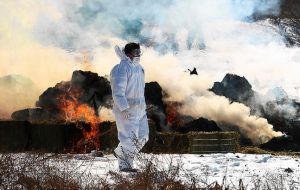MercoPress. South Atlantic News Agency
Foot and Mouth Worst Outbreak In South Korean History
 A health official helps to cull livestock from a farm affected by foot-and-mouth
A health official helps to cull livestock from a farm affected by foot-and-mouth South Korea's farm minister has offered to step down over the worst outbreak of foot-and-mouth disease in the country's history.Almost three million cattle have so far been culled at a cost of $1.34bn (£841m) since the disease was first confirmed last November.
Tens of thousands of other cattle have been vaccinated in a bid to stop the disease from spreading.
Yoo Jeong-bok, who became farm minister last September, has faced criticism from politicians and the media over the department's response to the disease's re-emergence.
Speaking to reporters on Friday Jeong-bok said: “I plan to do my utmost to try to contain the foot-and-mouth outbreak as soon as possible. ”Once the situation comes under control, I will step down.”
It is just eight months since the government claimed to have eradicated foot-and-mouth from the country.
Meanwhile the Food and Agriculture Organisation (FAO) called upon veterinary and border control authorities in Asia to be on the look-out for animals showing signs of infection of foot and mouth (FMD), following the recent outbreak.
Since late November 2010, South Korean authorities have imposed quarantines, initiated a vaccination campaign that is targeting nine million pigs and three million heads of cattle, and culled 2.2 million livestock. The overall cost of this effort is estimated at around $1.6 billion.
“The current FMD dynamics in eastern Asia, as well as the magnitude of the outbreak in South Korea, are unlike anything that we've seen for at least a half century,” said Juan Lubroth, FAO's Chief Veterinary Officer. “This makes preparedness and monitoring extremely important right now.”
“Authorities in Asia should make sure they are in a position to detect any instances of the disease and respond rapidly in an appropriate way. FAO is advocating proactive vaccination campaigns designed to stop the spread of the disease,” he said.
“FMD must be tackled as a regional problem, which is why FAO through its Regional Office for Asia and the Pacific is planning to organize a meeting of chief veterinary officers of East Asian countries to discuss the current situation and possible coordinated responses,” added Subhash Morzaria, Asia Region Manager of FAO's Emergency Centre for Transboundary Animal Disease Operations.
Lubroth also noted that when responding to outbreaks, countries should adhere to accepted practices that adequately take animal welfare and environmental impacts into account.
Media reports of an FMD outbreak in North Korea have not been confirmed by authorities there.
In recent years new strains of FMD virus have spread throughout China and eastern regions of Russia and Mongolia. FMD recently affected large numbers of Mongolian gazelles, among a total population estimated between two and 5.5 million. FAO sent an emergency response team to Mongolia to help authorities cope with the disease.
The overall situation in Asia is cause for concern, said Lubroth, especially given the approaching Lunar New Year holiday, during which large numbers of people will be on the move in the region, many of them carrying meat products and some transporting animals.
FMD is a highly contagious disease affecting cattle, buffaloes, sheep, goats, swine and other cloven-hoofed animals. It causes blisters on the nose, mouth and hooves and can kill young or weak animals. There are several types of FMD viruses. The type causing the outbreak in South Korea is Type O.
The disease does not pose a direct health threat to humans, but affected animals become too weak to be used to plough the soil or reap harvests, and farmers cannot sell the milk they produce due to infection by the virus.
One of the early signs of the disease in infected animals is the excessive production of saliva and nasal discharges. The FMD virus may survive for several hours outside the infected animal, especially in cold and humid environments. This means it can be transported on almost any object that has been in contact with contaminated saliva or other discharges.
The cost of cleaning farms and culling animals is a burden for farmers, and trade restrictions based on disease outbreaks can have major impacts on both local and national economies.
Costs resulting from an FMD outbreak in the U.K. in 2001 have been estimated at 13 billion euro.
Vaccination is key
With FMD introductions on the increase, the question arises whether large scale culling should remain the preferred method of dealing with FMD occurrences, or if vaccination should play a much more important role.
“Emergency vaccination with the aim to disrupt disease transmission and assist progressive elimination is increasingly applied, particularly during the peak of an epidemic, so as to buy time during culling operations. Vaccination can also be applied to protect animals and keep them alive and productive,” said Lubroth.
“Today we have tests that can distinguish between animals that were infected and animals that were vaccinated, making it easier for countries to re-obtain certification of FMD-freedom after recovering from an outbreak,” he said.




Top Comments
Disclaimer & comment rulesCommenting for this story is now closed.
If you have a Facebook account, become a fan and comment on our Facebook Page!